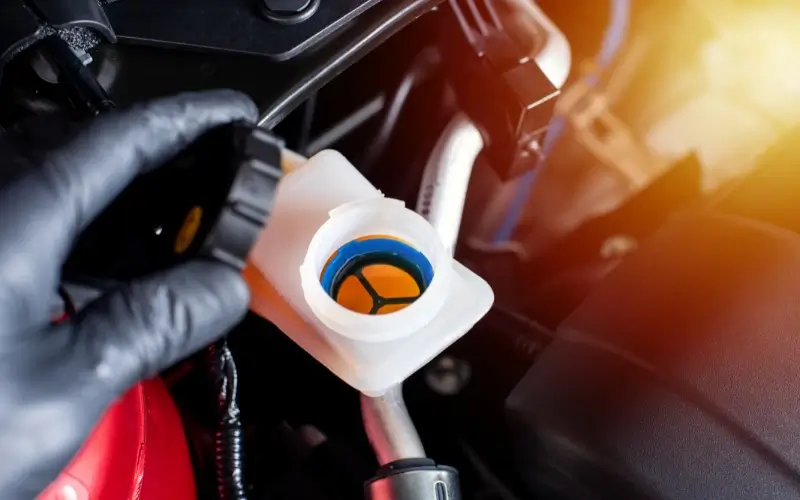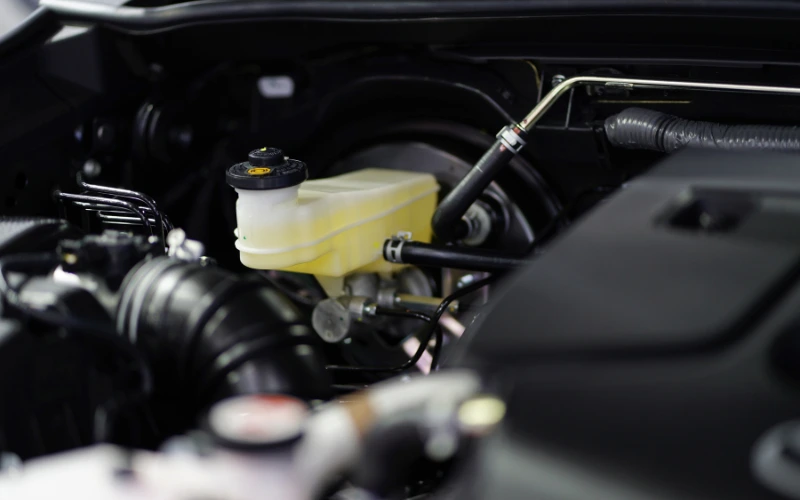Clutch Fluid 101: Signs, Causes, and Solutions
29 May 2025

Have you ever pressed the clutch pedal and found it spongy and difficult to change gears? This could be a sign of low clutch fluid.
Maintaining the right amount of clutch fluid is essential for smooth clutch operation and gear changing. Without the right level of clutch fluid, you could experience unusual sounds or the pedal sticking, which can lead to bigger problems.
In this guide, we’ll help you understand the causes of low clutch fluid, signs to look out for and solutions for restoring your clutch system.
What happens when clutch fluid is low?
If your clutch fluid is low, you might struggle to change gears, the clutch pedal might feel tough or spongy, or the clutch might slip or gears may grind. This can make your clutch unresponsive or difficult to engage, so your vehicle is difficult or even impossible to drive.
If low clutch fluid is left untreated, you could experience total failure of your clutch system. This can be dangerous and scary while you are driving as you’ll lose connection between the transmission and the engine and your vehicle will come to a stop. Not only that, but it can be costly, labour-intensive and complex to repair.
Always consult your vehicle owner’s manual before adding or changing fluids, even clutch fluids.
What does clutch fluid do?
To avoid clutch problems or a complete failure, check your clutch fluid regularly and top it up. Clutch fluid is a type of hydraulic fluid that transfers force from the clutch pedal to the clutch mechanism, enabling smooth gear engagement and disengagement. In many vehicles, it shares the same reservoir as the brake system.
Are brake and clutch fluid connected?
Brake fluid and clutch fluid are related in vehicles with hydraulic clutch systems and often share the same fluid reservoir and hydraulics system. So, if you have low brake fluid, you could experience problems engaging and disengaging the clutch, clutch slippage or a spongy clutch pedal.
What is the difference between clutch fluid and brake fluid?
Many cars, especially modern cars, use the same fluid for the clutch and brake system. It is often referred to as brake fluid, clutch fluid or hydraulic fluid, so there really isn’t any difference at all. DOT fluid is typically used to operate both systems, so a drop in ‘brake fluid’ can compromise the clutch system too.

What are the common signs of low clutch fluid?
Signs of low clutch fluid may be subtle at first but if left untreated, they can lead to much bigger issues that could be much more expensive to repair. Some common signs of low clutch fluid include:
-
Soft or spongy clutch pedal
If your clutch feels soft, spongy or low to the ground, this is a classic sign of low fluid. If it’s working correctly, your clutch pedal should feel smooth and springy but low clutch fluid can cause the pedal to become unresponsive.
In this case, there is likely air trapped in the system that will need to be bled out and your clutch fluid will need topping up to rectify the issue.
-
Difficulty shifting gears
Can you hear grinding noises when you’re trying to change gear? If so, you’ve probably noticed that changing gear is almost impossible. If your clutch fluid has reached a level that is causing your gears to grind, the pedal is probably having difficulty moving the slave cylinder while your clutch remains engaged with the flywheel.
-
Unusual sounds
Strange sounds when you press the clutch pedal can indicate you’ve got a problem. You may hear grinding, squeaking or chirping noises which could indicate extensive damage that needs to be assessed.
-
Pedal sticking or not returning
Most modern cars have a hydraulic clutch system which transfers clutch fluid from the master cylinder to the slave cylinder. If the fluid is low or not transferring efficiently, you’ll likely experience issues with the pedal sticking or not returning when pressed.
If you have noticed any of these symptoms, you need to take your car to a mechanic. They will be able to assess whether the clutch fluid is just low or if there is a bigger issue that needs to be repaired or replaced.
Top 3 causes of low clutch fluid
Low clutch fluid can be caused by several issues, so pinpointing the cause is key to fixing the issue and preventing it from happening again. Here are the top 3 most common causes of low clutch fluid:
|
Cause |
What Happens |
What To Do |
|
Fluid Leaks |
Leaks in the clutch master/slave cylinder or hydraulic lines cause fluid loss. |
In older cars, fluid can gradually evaporate, especially without regular checks. |
|
Ageing Components |
Worn seals or parts can reduce fluid efficiency and cause further damage. |
Replace aging components through professional servicing. |
|
Evaporation |
In older cars, fluid can gradually evaporate, especially without regular checks. |
Maintain fluid levels and get a proper diagnosis from a garage. |
Whatever the cause of low clutch fluid, it can be a serious issue and present failures while driving, such as complete failure of the master cylinder or clutch system. Either can make your car extremely unsafe and impossible to drive. So, it’s important to top up clutch fluid or get your car to a garage straight away if it does not resolve.
How to fix low clutch fluid
Fixing the issue of low clutch fluid can be very straightforward if caught soon enough by following these simple maintenance tips.
Check your clutch fluid levels
Many modern clutch fluid reservoirs are transparent so you can see the fluid level through the reservoir without removing the lid. They are usually marked with MIN and MAX so you can see if there is enough fluid. The reservoir is located under the bonnet and is often closer to the windscreen on the driver’s side. You will notice it from the yellow warning sign, ‘book’ and hexagonal shield symbols on the lid.
In older vehicles that don’t have a transparent reservoir, you may need to remove the lid and use a dipstick to check the levels. If it is less than ⅔ full, it will need topping up with fresh fluid. You should check clutch fluid levels when the engine is cool.
Top up your clutch fluid
Once you’ve determined your clutch fluid is too low, it will need topping up. Clutch fluid is typically DOT brake fluid, which is also used for the braking system. You should check your owner’s manual to determine which fluid is right for your vehicle.
To top up the fluid, wear protective gloves and pour the appropriate fluid into the reservoir until it is about ⅔ full. Then, replace the lid on the reservoir and close the bonnet.

When to get professional help
If you are experiencing regular issues with low clutch fluid, this could indicate a more serious problem. You could have problems with worn seals, leaks, evaporating fluid or damage to the master cylinder. If you suspect this could be the case, you should take your car to a mechanic who can diagnose and repair the issue as these are not easily fixed by topping up clutch fluid.
By regularly checking and maintaining your clutch fluid levels, you can prevent a lot of issues from occurring. But if you notice that you’re experiencing low clutch fluid early enough, you can often rectify the problem before any major damage occurs. By carrying out regular maintenance checks and familiarising yourself with the engine of your vehicle, it could make it easier to recognise potential problems before costly damage occurs.
Need some more information about car care and maintenance? Take a look at other helpful blog posts:

